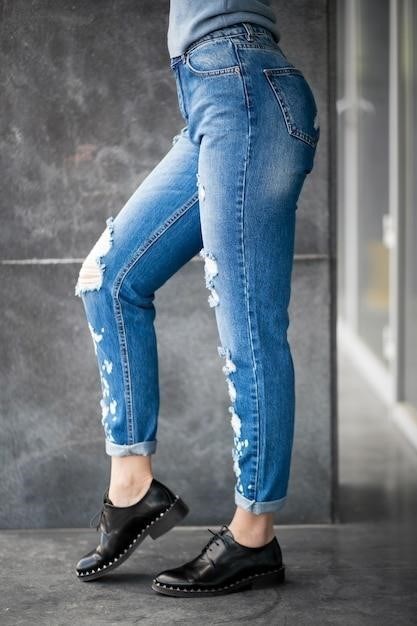Jeans Size Guide⁚ Finding Your Perfect Fit
Finding the perfect pair of jeans can be a challenge, but with the right information and guidance, you can find the perfect fit for your body and style. Our detailed guide will help you understand jeans sizing, measure yourself accurately, and choose the right size for different styles of jeans.
Understanding Jeans Sizing
Jeans sizing can be confusing, as different brands and styles use varying measurements. Generally, jeans are sized based on waist and hip measurements in inches. For example, a size 4 fits waists 26-27 and hips 35-36. Most brands size up by half-inch increments. So a size 6 has a 27-28 waist and 36-37 hips. Understanding these basic sizing principles is crucial for finding the right fit. However, remember that sizing can vary significantly between brands, and it’s always recommended to refer to individual brand size charts for the most accurate information.
Waist and Hip Measurements
Accurate waist and hip measurements are essential for finding the right jeans size. To measure your waist, wrap a tape measure around your natural waistline, which is the narrowest part of your torso, just above your hip bones. Make sure the tape is snug but not too tight. For hip measurements, stand with your feet together and wrap the tape measure around the fullest part of your hips, ensuring it sits horizontally. These measurements will provide you with a starting point for determining your jeans size, but remember that individual brand size charts may vary slightly.
Inseam and Leg Length

Inseam refers to the length of your inner leg, measured from the crotch to the bottom of your ankle. This measurement is crucial for determining the appropriate length of your jeans. To measure your inseam, stand with your feet together and measure from the crotch seam of your pants to the bottom of your ankle. For an accurate measurement, use a flexible tape measure and ensure it runs straight down your inner leg. Knowing your inseam will help you choose jeans that fit perfectly, whether you prefer a cropped, ankle-length, or full-length style.
Size Conversion Charts
Size conversion charts are invaluable tools for navigating the complexities of international sizing. They provide a clear understanding of how sizes translate across different countries and brands. For instance, a size 8 in the UK might correspond to a size 40 in Europe or a size 4 in the US. These charts are especially helpful when shopping online, as they allow you to compare sizes and ensure you’re ordering the right fit. When using conversion charts, it’s important to note that they are not always exact, as sizes can vary between brands. It’s always recommended to refer to the specific brand’s size guide for the most accurate information.
International Sizing
International sizing can be a bit confusing, as different countries use different numbering systems. For example, a size 8 in the UK might be a size 36 in Europe or a size 4 in the US. To avoid confusion, it’s helpful to use size conversion charts. These charts provide a clear translation between different sizing systems. When shopping online, look for size guides that include international sizing conversions to ensure you’re ordering the right fit. Keep in mind that sizes can vary between brands, so it’s always best to check the specific brand’s size guide for the most accurate information.
Brand-Specific Size Guides
Beyond general sizing charts, many clothing brands have their own size guides specific to their products. These guides are often more accurate than generic charts as they take into account variations in cut, fabric, and style. It’s essential to check the size guide for the particular brand you’re interested in, especially if you’re shopping online. You can usually find these guides on the brand’s website or product pages. Brand-specific size guides provide detailed measurements and fit information for each item, ensuring you choose the perfect size for your individual body shape and preferences.
Tips for Measuring Yourself
Accurate measurements are crucial for finding the right jeans size. Here’s how to measure yourself for a perfect fit⁚
To ensure accurate measurements, use a flexible tape measure and stand upright with your feet together. For the most reliable results, wear only underwear while measuring. Don’t pull the tape measure too tightly; it should fit snugly but not be constricting. Repeat each measurement a few times to ensure consistency. Once you have your measurements, refer to the size charts for the brand you’re shopping from to find the most accurate fit.
Waist Measurement
To measure your waist, wrap the tape measure around your natural waistline, which is the narrowest part of your torso, usually just above your belly button. Keep the tape measure level and snug, but not too tight; Make sure the tape measure doesn’t slip up or down. Take a deep breath and exhale, and note the measurement at the end of your exhale. This measurement will help you determine the correct waist size for your jeans.
Hip Measurement
To measure your hips, stand with your feet together and wrap the tape measure around the fullest part of your hips, which is typically just below your hip bones. Ensure the tape measure is level and snug but not too tight. Make sure the tape measure doesn’t slip up or down. Take a deep breath and exhale, and note the measurement at the end of your exhale. This measurement will help you determine the correct hip size for your jeans.
Inseam Measurement
The inseam measurement is crucial for determining the correct length of your jeans. To measure your inseam, stand with your feet together and extend one leg straight out in front of you. Use a measuring tape to measure the distance from the crotch seam of your pants to the bottom of your ankle. Make sure to keep the tape measure straight and close to your leg. The inseam measurement is typically in inches, and it will help you find the perfect length for your jeans, whether you prefer a cropped or a full-length style.
Finding the Right Size for Different Styles
Different jean styles require different fits, so understanding the nuances of each style is essential for finding the right size. Skinny jeans, for example, are designed to hug your legs and are often available in sizes that are a bit more snug than other styles. Straight leg jeans, on the other hand, have a more relaxed fit that falls straight down from the hip to the ankle. Wide leg jeans offer a flowy and comfortable fit, while bootcut jeans are slightly flared from the knee to the ankle, creating a flattering silhouette. Flare jeans, also known as bell bottoms, have a wide, flared leg that starts from the knee or thigh and creates a dramatic and stylish look.
Skinny Jeans
Skinny jeans are designed to hug your legs closely, creating a sleek and streamlined silhouette. They are often made from a stretch denim that allows for flexibility and comfort. When choosing skinny jeans, it’s essential to select a size that fits snugly but doesn’t feel constricting. You may want to consider going up a size if you prefer a slightly looser fit. It’s also important to pay attention to the inseam length to ensure that the jeans hit your ankles at the desired point.
Straight Leg Jeans

Straight leg jeans offer a classic and versatile fit that complements a wide range of body types. They are characterized by a straight line from the hip to the ankle, creating a balanced and flattering silhouette. When choosing straight leg jeans, it’s crucial to select a size that fits comfortably at the waist and hips, with the legs falling straight down without bunching or feeling too tight. Ensure the inseam length is appropriate for your height, allowing for a comfortable fit without being too short or long.
Wide Leg Jeans
Wide leg jeans embrace a relaxed and flowing aesthetic, featuring a wider leg opening that creates a dramatic and stylish silhouette. When determining the right size for wide leg jeans, consider the overall fit and drape. Choose a size that fits comfortably at the waist and hips, allowing the wide legs to fall gracefully without feeling too loose or bulky. The inseam length should be appropriate for your height, ensuring the jeans drape elegantly without being too short or long. Experiment with different styles and fabrics to find the perfect wide leg jeans for your personal taste.
Bootcut Jeans
Bootcut jeans are a versatile style that offers a flattering fit for a variety of body types. They feature a straight leg from the thigh to the knee, gradually widening towards the ankle, creating a slightly flared look. When choosing the right size for bootcut jeans, prioritize a comfortable fit at the waist and hips. Ensure the legs are not too tight or loose, allowing for a smooth and flattering drape. The inseam length should be appropriate for your height, allowing the jeans to hit your shoes or boots gracefully, without being too short or long. The slight flare at the ankle provides a balanced and stylish look, enhancing the overall silhouette.
Flare Jeans
Flare jeans, also known as bell bottoms, are a classic style that has made a comeback in recent years. These jeans feature a straight leg from the thigh to the knee, with a dramatic widening towards the ankle, creating a flowing and feminine silhouette. When selecting the right size for flare jeans, it’s crucial to consider the fit at the waist and hips. The legs should be comfortable without feeling too tight or loose. The inseam length is essential, allowing the jeans to gracefully hit your shoes or boots. The wide flare at the ankle adds a touch of drama and elegance, making flare jeans a perfect choice for both casual and more formal occasions.
Online Shopping Tips
Shopping for jeans online can be daunting, but with a few smart strategies, you can find the perfect fit without ever stepping into a fitting room. First, take advantage of the size charts provided by retailers. These charts offer detailed measurements for each size and style, helping you determine the correct fit for your body type. Next, read the product descriptions carefully, paying attention to the specific details about the fabric, rise, and leg style. Lastly, don’t underestimate the power of customer reviews. Read what other shoppers have said about the fit and sizing of the jeans you’re considering, as their experiences can provide valuable insights into how the jeans run true to size or if they tend to run larger or smaller.
Using Size Charts
Size charts are your best friend when shopping for jeans online. Most retailers provide detailed size charts that outline the waist, hip, and inseam measurements for each size and style. Take your own measurements accurately using a measuring tape and compare them to the size chart. If you fall between sizes, opt for the larger size for a more comfortable fit. Keep in mind that size charts can vary slightly between brands, so it’s always a good idea to check the specific size chart for the brand you’re shopping with.
Reading Product Descriptions
Don’t skip over the product descriptions! They often provide valuable information that can help you choose the right size. Look for details about the fit, rise (how high the waistband sits), stretch, and fabric content. Some descriptions will even mention whether the jeans are true to size or run large or small. Pay close attention to these details, as they can help you avoid buying jeans that are too tight or too loose. Reading the descriptions thoroughly can save you time and hassle in the long run.
Checking Customer Reviews
Customer reviews are a valuable resource for understanding how jeans fit and how they compare to other brands. Read through reviews carefully, paying attention to comments about sizing, fit, and comfort. Look for reviews from customers with similar body types to yours. If a majority of reviewers say the jeans run small or large, adjust your size accordingly. Customer reviews can also give you insights into the quality of the jeans, the durability of the fabric, and the overall satisfaction of previous buyers. This information can help you make an informed decision and avoid any surprises with your purchase.


